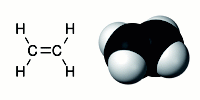A research team at the US Department of Energy has developed a high temperature resistant membrane capable of producing ethylene from an ethane stream by removing pure hydrogen, where the removed hydrogen provides energy for the production process

A research team at the US Department of Energy has developed a high temperature resistant membrane capable of producing ethylene from an ethane stream by removing pure hydrogen.
"This is a clean and energy-saving way to create a chemical, the production of which in the past required methods that were expensive and wasteful and also emitted large amounts of impurities," says the lead researcher. Ethylene has the most uses in all aspects of industry: farmers and gardeners use it as a plant hormone to speed up flowering and ripening, especially in bananas;
Doctors and surgeons have long used ethylene as an anesthetic, while ethylene-based polymers are found in almost every product from shopping bags to pipes. Since the new membrane allows for the selective passage of hydrogen only, the ethane stream does not come into contact with atmospheric oxygen and nitrogen, thus preventing the contamination of the greenhouse gases - nitrogen oxides, carbon monoxide and dioxide - gases obtained by the existing methods of creating ethylene such as pyrolysis (burnt decomposition) in which the ethane exposed to high heat currents. Over 60 million tons of polyethylene are produced in the world annually, a fact that causes the emission of millions of liters of greenhouse gases.
Unlike pyrolysis, which requires constant external heat consumption, a 'Hydrogen Transport Membrane' (HTM) produces the energy required to drive the chemical reaction. By using atmospheric air from one side of the membrane, the hydrogen that has already passed through it reacts with the oxygen to create the energy needed for the process. "By using this membrane, we essentially allow the reaction to feed itself," says the researcher. "The energy is produced exactly where it is needed."
The new membrane performs another chemical trick: by continuously removing hydrogen from the stream, it changes the reactant-product ratio and thus allows the reaction to create more and more ethylene, which in theory could reach chemical equilibrium with the existing methods. "We are actually deceiving or confusing the theoretical thermodynamic threshold," says the researcher.
"The membrane 'thinks' to itself: 'Hey, I haven't reached equilibrium yet, let's continue with the reaction further.'" Cooperation with the industry that will produce the membrane commercially. Since the membrane reduces the number of steps needed to create ethylene, the technology could enable its creation in a cheaper way, the researcher claims. The results of the research should be presented at the Clean Technologies Conference 2008 which will be held in Boston in June.

One response
What a beauty!
I like studies like this that simplify long and expensive processes, and optimize the industry.
Commercial companies reduce production costs, and this makes managers want to be even more efficient (to save costs) and more resources are invested back into research and development.